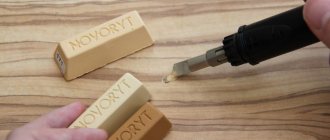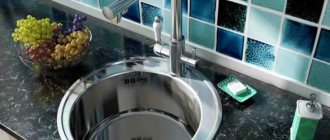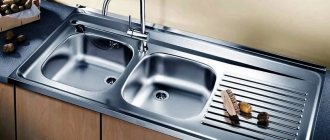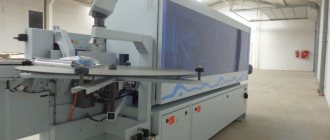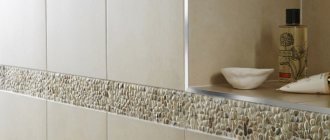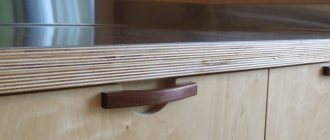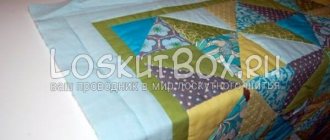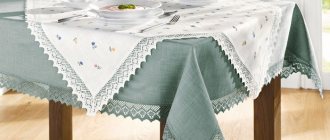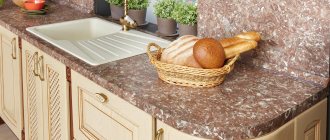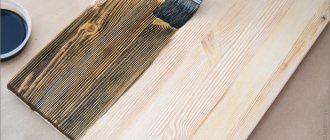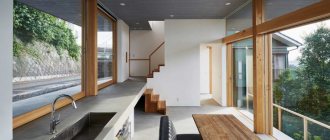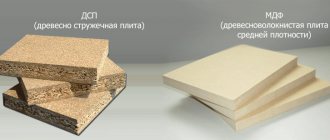The low cost of chipboard, high performance characteristics, and versatility of use have made them a very popular material. The most common areas of application are furniture production and construction.
The main enemy of these slabs is water - the chips increase in volume, the slab swells, warps and crumbles.
Even at the very beginning of production, sawdust and shavings, after drying, are impregnated with formaldehyde resins. After pressing, the surface of the boards is laminated, sometimes even varnished.
But protecting the surface does not prevent the penetration of moisture from the ends through which it enters. Accumulating inside, water gradually begins to penetrate the wood fibers, which leads to the destruction of the slab.
Consequently, the ends must first be saved from liquid penetration during operation. If they are tightly sealed, the service life of the slabs will be much longer.
The photo shows the effects of water on a chipboard countertop.
Why are the ends the starting point for destruction? Yes, because the production of slabs of the required standard sizes, as well as the preparation of pieces of material of different sizes, requires cutting. In this case, the integrity of the wood fibers is compromised.
Thus, chipboard protection from moisture is carried out in three directions:
- impregnation of wood fibers with resins;
- special surface treatment;
- end sealing.
How to protect a wooden tabletop?
Oil impregnation is a universal method of protecting wood products, which is excellent for providing a water-repellent barrier on the surface of wood fibers. The oil is absorbed into the countertop, thereby preventing the fibers from swelling when wet.
Interesting materials:
What to do with sandy soil? What to do with the assigned one? What to do with silica gel? What to do with boiled crayfish? What to do with dried paint? What to do with a broken Peduncle? What to do in Gorno-Altaisk in winter? What to do in St. Petersburg for 7 days? What to add to porridge for taste? What to add to paint for trees so that it doesn't wash off?
Surface treatment of plates
The front and back surfaces of the slab, as the largest contact areas, without any protection, can pass through and absorb, accordingly, the largest amount of liquid. It would be a good idea to cover these surfaces with something moisture-proof. Some of the methods of such coating are possible only in factory conditions, some are also possible at home.
One of the main methods of protection is lamination. In this case, a melamine film is laid on sanded chipboard at high pressure and high temperature. The essence of this process is not pressing, but the fact that under these conditions the film polymerizes the surface of the slab, becoming one with it.
There is another method that is performed in the factory - laminating. Pressure and heat are also used here, but more gentle. The already hardened film is pressed against the glue-coated slab. If lamination is a chemical process, then laminating is a mechanical process.
Components of laminated chipboard
At home, non-laminated chipboard is often coated with several layers of paint for protection. Before painting, pre-treat the surface:
- dust is carefully swept away and washed off the surface;
- for the first time, the plate is coated with hot drying oil;
- then this is done with cold drying oil until an outer crust forms;
- the top is painted. With any painting method, you must remember that each subsequent layer of paint is applied to the already dried previous one.
There are several other ways to protect yourself from getting wet. For example, a surface that will not be subject to mechanical stress can be protected as follows: rub it with stearin, then heat it with a hairdryer. Let cool and repeat this a couple more times. Or: one part of bitumen varnish is mixed with five parts of drying oil. Coating is carried out twice.
How to properly update and care for your countertop
You can update your countertop in different ways. Here everything depends on the author’s imagination. One of the simplest methods is painting and decorative painting. You can also cover it with decorative tiles, such as mosaics. Using tempered glass is the most expensive method. To ensure that the results of the restoration are pleasing for as long as possible, be sure to use cutting boards and hot mats for cutting food. And for washing, use gentle cleaning products.
What is the gap between the kitchen and the wall?
According to GOST, a technological gap is required. It should be no more than 5 mm. That is, if your furniture has a small indentation from the wall or ceiling, it’s okay. On the contrary, it is rather an indicator of the professionalism of the designer-consultant and measurer.
Interesting materials:
Is it possible to get MTPL insurance for 6 months? Is it possible to provide hairdressing services at home? Is it possible to describe a circle around a quadrilateral that has only one right angle? Is it possible to describe a circle around a rectangular trapezoid? Is it possible to describe a circle around a square? Is it possible to pay for halva at McDonald's? Is it possible to pay taxes through my personal account? Is it possible to determine the location of a subscriber without his knowledge? Is it possible to define the process of perception as a synthesis of sensations? Is it possible to determine the case of short adjectives?
Methods for treating chipboard from moisture
Chipboard is an excellent construction material, but is not very attractive in comparison with wood, and is also particularly susceptible to environmental factors. Products made from chipboard receive certain protection during the manufacturing process. For this, all kinds of impregnations and additives are used. However, under intensive operating conditions, such factory measures are not enough, so it is recommended to further protect the material. How to protect chipboard, as well as treat it with finishing materials, will be discussed below.
- Surface treatment of plates
- Lamination
- Laminating
- Paint coating
- Finishing with paper-laminated polymers
- Pasting with polymer films
- Vacuum pressing
- Veneering
- Table top made of chipboard or MDF
- Protection of joints and edges
- Protection of joints on the floor
Surface treatment of plates
The front and interior of the slab have the largest areas, so if they are not protected, they will absorb the most moisture. At the same time as protection, you can decorate the material. Below are several such techniques.
Lamination
The lamination process involves finishing chipboard with paper-resin films. The lining is carried out at high temperature (150-200 degrees) and high pressure (25-30 MPa). The protective and decorative layer occurs due to the spreading of hot resin over the surface. The resin then polymerizes, forming a hard, uniform coating.
If the technological process is followed, reliable adhesion occurs between the chipboard and the resin. During lamination, a certain surface texture is created - usually glossy or “wood-like”. Laminated surfaces are resistant to mechanical stress, moisture, ultraviolet radiation and high temperatures.
Laminating
During lamination, the chipboard is covered with an adhesive layer, on which hard paper-resin unvarnished films are then placed. The difference between lamination and lamination is that when laminating, the decorative coating is glued to the slab in finished form. For example, wood grain embossing is done in advance. Such films are called “finishing films”.
As in the case of lamination, when processing material using the laminating method, increased pressure and high temperature are also used. However, the parameters in this case are more gentle: temperature - from 20 to 150 degrees, pressure - from 5 to 7 MPa.
The disadvantage of laminating is that the coating is unstable to mechanical stress and moisture. This surface is easily scratched and swollen. Lamination is used mainly in the manufacture of inexpensive furniture, as well as for the production of parts that are not subject to aggressive environmental influences (for example, the back walls of a cabinet).
Paint coating
A non-laminated chipboard sheet can be coated with several layers of paint and varnish material. The sequence of work on painting chipboard is presented below:
- remove dust and dirt from the sheet;
- coat the chipboard sheet with heated drying oil;
- coat the sheet again, but this time with cold drying oil (a thin crust should appear);
- apply the first layer of paint;
- After the first layer has dried, apply the second.
Finishing with paper-laminated polymers
Laminated plastic is a polymer in which there are niches for filler. Fabric, paper, veneer and other materials are used as filler. The basis for the manufacture of paper-laminated filler is paper. It acts as a reinforcing layer, and also gives the layered polymer ductility, strength and visual appeal.
Finishing begins with cutting chipboard sheets of the required size. Using compressed air and brushes, dirt and dust are removed from the sheets. If contaminants are not removed before painting, high-quality adhesion will not work.
The gluing of the facing material is carried out by direct pressing of a paper-laminated polymer, onto which glue and chipboard are previously applied. Pressing can be done hot (using adhesives based on urea or PVA) or cold (using PVA dispersion contact adhesives). In practice, cold pressing is not used very often, since the process requires large areas and the productivity is relatively low.
The finishing is completed by postforming. The task is to give the plastic curves and other irregular shapes. The process is carried out on special equipment at elevated temperatures.
Pasting with polymer films
The process of applying polymer films is similar to decorative cladding with plastics. The difference lies in the materials used. In this case we are talking about a thermoplastic film applied by pressing to chipboard treated with an adhesive composition.
Polyvinyl chloride films are used for finishing chipboard. Polystyrene and acrylic films are occasionally used.
Finishing with polymer films is carried out on the same technological equipment on which finishing materials such as veneer or paper-laminated polymers are applied. The cladding process can be either hot or cold.
The advantage of cladding using the polymer method is the ability to process profile parts. However, the use of polymer films has limited potential, since the coating does not have high physical and mechanical properties and is also unstable to temperature influences.
Vacuum pressing
Vacuum (or, as it is otherwise called, membrane) pressing is a technological process during which furniture is covered with decorative film. The main advantage of the method is the ability to coat parts of complex shapes.
Where can I put such a table?
A table made from cut wood will look natural in the kitchen or living room in a number of interiors, such as folk style, ethnic style, rustic, country. But, of course, it is most optimal to make it for a country house.
Such tables fit well into almost any interior. Do-it-yourself furniture made from wood cuts will become the highlight of any interior. If you want to surprise guests with an unusual furniture design, then a beautiful coffee table made by yourself will be the ideal solution, because every detail and decorative element will be unique and convey exactly your idea and mood.
Processing joints and edges
Water always looks for the lowest place, the depression. And what, if not a recess, are joints on horizontal planes? There are especially many such joints in cabinet furniture, which is made from chipboard. Kitchen furniture in general is like on the front line: there is plenty of water and enough evaporation. The most susceptible to moisture are the sink, cabinet with dryer, countertop, and furniture near and above the stove.
The taps all start to leak at some point. So, the most potentially dangerous place in the sink is where the faucet crashes into the countertop. This is the point of contact between metal and wood. It is possible not only for the faucet to leak, but also for water to condense at the contact point.
Therefore, this place is cleaned and dried with a hairdryer. Next, a layer of PVA glue is applied, after which it dries - silicone. You can use construction sealant, this is also a silicone mass; it even seals window frames against leaks.
The edge not only protects the chipboard from moisture, but also reduces emissions of harmful substances
In the dish cabinet, you should check the presence or absence of a tray: if it is not there, the liquid, flowing to the bottom of the cabinet, will ruin it. For all kitchen furniture where it is possible to get wet, you need to make it a rule: degrease this area and then do not skimp on the sealant.
To seal the seams, it is better to use sanitary silicone of a suitable shade: dark mold spots will not appear on the surface.
Non-laminated edges of the tabletop are covered with connecting or end strips. They come in metal or plastic. The protection is not so great, so the end of the tabletop should first be treated with silicone. Another method of protection is to apply furniture varnish or PVA glue to the cut area. Self-adhesive films or tape offered by the construction market cannot be called reliable protection.
Features of protecting kitchen furniture from water
There are always risk areas in kitchen furniture that need to be monitored especially carefully. This is a cabinet with a dryer, a sink and a cabinet with a washing machine. They are often the reason for repairs or replacement of the headset. When purchasing, it is better to give preference to moisture-resistant material. However, the manufacturer only provides a guarantee for a solid tabletop. First of all, the correct selection and installation of furniture is important.
Correct installation of sink and faucet
When purchasing a sink, you should pay attention to the feature of the locking connection. The locks should snap onto the tabs and not just click. When installing, it is advisable to use silicone sealant. When drying, it forms a protective film that protects against moisture. A thick layer of sealant is usually applied to the joint between the countertop and the wall and the cutout under the sink. The sealant is easy to check for quality. To do this, leave the drop at room temperature for three hours. If it has frozen and does not leave marks on your hands, then the product can be safely used at work.
The table surface is the most vulnerable part of kitchen units.
Note! Experts do not recommend embedding the faucet directly into the countertop, as the faucet will sooner or later begin to leak. This will cause the surface to swell. An exception is made for drinking filters.
Drying installation
When choosing a dryer, you should pay attention to whether the set includes a tray. If it is not provided, then water draining from the dishes will fall to the bottom of the cabinet, which will subsequently lead to swelling of the surface. Good ventilation of the dryer is also necessary. To do this, make a small hole in the cabinet, which is designed in the form of a socket for the wire.
Most often, damage to countertops can be associated with manufacturing defects, improper installation or violation of operating rules.
Kitchen plinth protection
When choosing a kitchen plinth, it is better to give preference to plastic. The panel will close the gap between the cabinet and the floor. The design is equipped with grooves for fastening to supports and a seal that protects against the ingress of water and dirt. The advantages of the plinth are as follows:
- simplicity and ease of installation;
- a light weight;
- wide choice of colors;
- moisture resistance;
- different heights: 100, 120 and 150 mm.
The slab swells due to prolonged contact with water or improper care.
Protecting the edges of the tabletop
It is better to cover the edges with special strips, the choice of which depends on the installation method. The end is pre-treated with silicone. One of the popular techniques is to apply several layers of paraffin, PVA glue or varnish to the sections. Some people use self-adhesive tape or wide tape.
Blistering of the surface indicates that the installation was carried out with errors.
How to connect countertops in the kitchen?
To connect the tabletops through a special connecting element you need to: Treat the open cut of the tabletop with acrylic sealant to prevent water penetration. The sealant is applied with a rubber spatula in one or two layers. The connecting element is attached to one of the ends of the tabletop.
Interesting materials:
How to properly putty small cracks? How to properly remove a sticker from glass? How to properly remove henna from eyebrows? How to properly connect sections of cast iron batteries? How to properly preserve beets? How to properly store cauliflower for the winter? How to plan a workout correctly? How to argue with your boss? How to properly cut labels from clothes? How to properly put capsules in a coffee machine?
From the author
The background to the work described in this article is as follows. For the kitchen, a 2400 mm long kitchen worktop was ordered. Since the tabletop is sold in 3000 mm pieces, the manufacturer received a completely finished tabletop 2.40 cm long and the remainder of the tabletop 60 cm. It was this remainder that had to be glued to the edge of the tabletop.
Installing a countertop is a complex and time-consuming job that requires special tools and practical skills. Installing a countertop without practicing such work is almost impossible. Therefore, I recommend that if you do not have similar work experience, you invite professionals to install the countertops. The craftsmen of the company santex-mastera.ru, who can be invited on the website https://www.santex-mastera.ru/, will carry out professional installation of the countertops, using modern tools and linking them to your kitchen furniture.
Helpful tips for preventing swelling
Be sure to take advantage of the kitchen assembly service. Otherwise, the company will withdraw its warranty obligations. It is necessary to take care of the installation of the hood. It will not only get rid of unpleasant odors, but will also protect furniture from condensation, steam and grease drops. Remove moisture from the surface in a timely manner and do not leave it wet overnight. Otherwise, the material will begin to swell. The base can be rubbed with stearin and then heated with warm air. After cooling, repeat the procedure several times. You can make a coating from a mixture of bitumen varnish and drying oil in a ratio of 1:5.
Any countertop must be sealed, the joints coated with sealant and promptly wiped with an absorbent cloth.
Sometimes repairing an old countertop is more expensive than buying a new one. To extend the life of furniture, it is important not only to install it correctly, but also to properly care for it in the future.
If there is the slightest detachment of the protective layer, penetrating water quickly leads to swelling of the base.
Laminated models and their repair
Laminated surfaces, despite their durability, also wear out. If the tabletop is swollen, you can fix it in the following way:
- heat the deformed area with a hairdryer;
- remove the damaged piece;
- treat the damaged area with glue;
- pour the prepared mixture of sawdust and PVA into the damaged area;
- compact the mixture with a spatula;
- the surface should dry within 24 hours.
If the surface is not only damaged, but also swollen, a number of actions should be taken to restore the shape of the slab.
